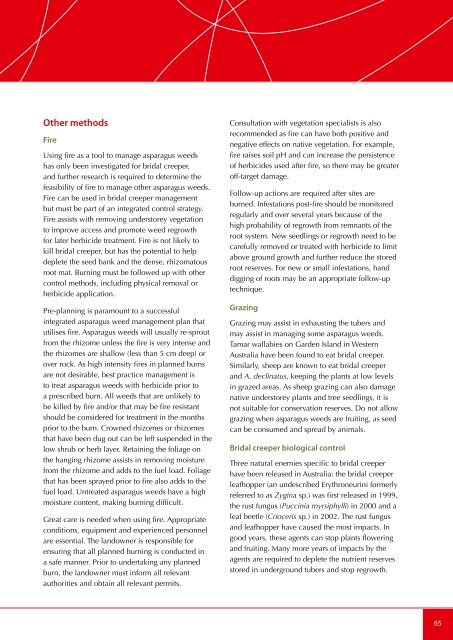Asparagus weeds - Weeds Australia
Asparagus weeds - Weeds Australia
Asparagus weeds - Weeds Australia
- No tags were found...
Create successful ePaper yourself
Turn your PDF publications into a flip-book with our unique Google optimized e-Paper software.
Other methodsFireUsing fire as a tool to manage asparagus <strong>weeds</strong>has only been investigated for bridal creeper,and further research is required to determine thefeasibility of fire to manage other asparagus <strong>weeds</strong>.Fire can be used in bridal creeper managementbut must be part of an integrated control strategy.Fire assists with removing understorey vegetationto improve access and promote weed regrowthfor later herbicide treatment. Fire is not likely tokill bridal creeper, but has the potential to helpdeplete the seed bank and the dense, rhizomatousroot mat. Burning must be followed up with othercontrol methods, including physical removal orherbicide application.Pre-planning is paramount to a successfulintegrated asparagus weed management plan thatutilises fire. <strong>Asparagus</strong> <strong>weeds</strong> will usually re-sproutfrom the rhizome unless the fire is very intense andthe rhizomes are shallow (less than 5 cm deep) orover rock. As high intensity fires in planned burnsare not desirable, best practice management isto treat asparagus <strong>weeds</strong> with herbicide prior toa prescribed burn. All <strong>weeds</strong> that are unlikely tobe killed by fire and/or that may be fire resistantshould be considered for treatment in the monthsprior to the burn. Crowned rhizomes or rhizomesthat have been dug out can be left suspended in thelow shrub or herb layer. Retaining the foliage onthe hanging rhizome assists in removing moisturefrom the rhizome and adds to the fuel load. Foliagethat has been sprayed prior to fire also adds to thefuel load. Untreated asparagus <strong>weeds</strong> have a highmoisture content, making burning difficult.Great care is needed when using fire. Appropriateconditions, equipment and experienced personnelare essential. The landowner is responsible forensuring that all planned burning is conducted ina safe manner. Prior to undertaking any plannedburn, the landowner must inform all relevantauthorities and obtain all relevant permits.Consultation with vegetation specialists is alsorecommended as fire can have both positive andnegative effects on native vegetation. For example,fire raises soil pH and can increase the persistenceof herbicides used after fire, so there may be greateroff-target damage.Follow-up actions are required after sites areburned. Infestations post-fire should be monitoredregularly and over several years because of thehigh probability of regrowth from remnants of theroot system. New seedlings or regrowth need to becarefully removed or treated with herbicide to limitabove ground growth and further reduce the storedroot reserves. For new or small infestations, handdigging of roots may be an appropriate follow-uptechnique.GrazingGrazing may assist in exhausting the tubers andmay assist in managing some asparagus <strong>weeds</strong>.Tamar wallabies on Garden Island in Western<strong>Australia</strong> have been found to eat bridal creeper.Similarly, sheep are known to eat bridal creeperand A. declinatus, keeping the plants at low levelsin grazed areas. As sheep grazing can also damagenative understorey plants and tree seedlings, it isnot suitable for conservation reserves. Do not allowgrazing when asparagus <strong>weeds</strong> are fruiting, as seedcan be consumed and spread by animals.Bridal creeper biological controlThree natural enemies specific to bridal creeperhave been released in <strong>Australia</strong>: the bridal creeperleafhopper (an undescribed Erythroneurini formerlyreferred to as Zygina sp.) was first released in 1999,the rust fungus (Puccinia myrsiphylli) in 2000 and aleaf beetle (Crioceris sp.) in 2002. The rust fungusand leafhopper have caused the most impacts. Ingood years, these agents can stop plants floweringand fruiting. Many more years of impacts by theagents are required to deplete the nutrient reservesstored in underground tubers and stop regrowth.65
















